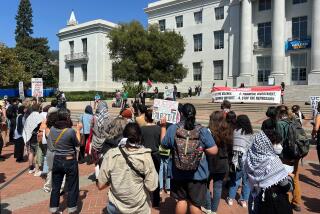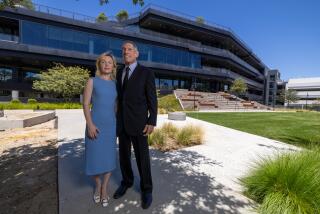Building on reputation
An early death, big money, beloved character, academic brilliance: Those are some attributes that get a prominent building or plaza named after you at one of Californiaâs colleges and universities. Many schools boast landmarks bearing the monikers of generous alumni. But some can tout landmarks named after a U.S. president, the author of childrenâs books or a motherly custodian. Here is a sampling from across the state, with a bias for architectural and historical distinction.
Royce Hall
UCLA
Royce Hall was one of the Westwood campusâ original four buildings after the school moved in 1929 from its previous site on Vermont Avenue.
Modeled after a Milan basilica in the Romanesque style, it includes two towers, rounded Roman arches and a covered loggia. Its 1,829-seat auditorium under a coffered ceiling has played host to such luminaries as Albert Einstein, John F. Kennedy, George Gershwin and Duke Ellington. Damaged in the 1994 Northridge earthquake, Royce was closed four years for extensive renovation.
Its namesake, philosopher and historian Josiah Royce, died in 1916, three years before a Los Angeles teacher-training school became part of the university. But his intellectual interests deeply influenced higher education on the West Coast, partly through UCLAâs early faculty and deans who had been his colleagues and students at Harvard.
Royce, who was born in a California mining camp in 1855, earned a bachelorâs degree from the then-new University of California at Berkeley, where he later taught. He also received a doctorate from Johns Hopkins. Royce championed the idea that universities should seek truth rather than just transmit information.
Geisel Library
UC San Diego
When this striking building opened in 1970, the concrete and glass structure designed by William Pereira struck some as the essence of contemporary or even futuristic architecture. It looked like a spaceship on the La Jolla cliffs or an upside-down pyramid perched on a pedestal and soon became a symbol of the school. An underground expansion was added in 1993.
Originally known as the University Library Building, it was renamed after childrenâs author and illustrator Theodor Seuss Geisel -- otherwise known as Dr. Seuss -- and his widow, Audrey, in 1995. The Geisels, longtime residents of La Jolla, were great enthusiasts of the structure. Although the figure was never publicly revealed, she donated what was thought to be $20 million to the library.
Geisel, who died in 1991 at age 87, drew and wrote such beloved and vocabulary-building classics as âThe Cat in the Hat,â âOne Fish Two Fish Red Fish Blue Fishâ and âHow the Grinch Stole Christmas.â His 47 books have been translated into 20 languages and have sold more than 200 million copies. The library contains a collection of his original drawings, notebooks, books, tapes and other memorabilia.
âLittle Bridgesâ
Pomona College
Mabel Shaw Bridges, a student at Pomona College, died in 1907 at age 22 after a short illness. Her parents (âloyal to her dear memory and seeking to fulfill her high hopes of noble service,â according to a plaque) donated $100,000 to build what is considered an architectural and acoustical gem.
âLittle Bridges,â as it is known, opened in 1915 and has been a favorite of musicians and audiences ever since. Formally, itâs called the Mabel Shaw Bridges Hall of Music. (Donât confuse it with nearby Bridges Auditorium, or âBig Bridges,â the much larger space that opened in 1931 and was funded by the same San Diego family.)
Designed by Myron Hunt in a Spanish Renaissance Revival style, Little Bridges is fronted by a dramatic archway entrance and houses a 600-seat concert hall with seating on three sides. Six years ago, it underwent a $5.2-million renovation that included a new pipe organ and a restoration of the redwood ceiling with its stenciled ornamentation.
Sproul Plaza
UC Berkeley
The campusâ main outdoor gathering spot holds a prominent place in U.S. cultural history. In the fall of 1964, the Free Speech Movement erupted there with rallies against a ban on student political activities.
The movement helped fuel nationwide student protests against the Vietnam War but also led to a conservative backlash in California. Today, after a 2004 face-lift, the stone-paved plaza just off Telegraph Avenue is often crowded with recruiting tables for political, religious and ethnic organizations.
Robert Gordon Sproul was the University of Californiaâs 11th president and the first alumnus to lead the university system. From 1930 to 1958, he presided over its transformation into a multi-campus, internationally respected institution. But Sproulâs anticommunism stance and insistence on employee loyalty oaths led to a faculty uproar in 1949. He died in 1975 at age 84.
The steps in front of Sproul Hall were named in 1997 for Mario Savio, the student leader who electrified crowds there in 1964. Savio died in 1996 at age 53.
Mary Park Hall
San Francisco State University
This six-story dormitory at the southwest corner of campus did not win any design awards when it opened in 1960 as the home away from home for 410 undergraduates. Now it seems a pleasant if utilitarian dorm, its exterior painted in yellow, terra cotta and beige.
Originally dubbed Merced Hall, the building was renamed in 1981 in honor of Mary Park, a university employee who retired that year after three decades with the college -- 10 years as a food server and custodian and 20 years as supervising custodian for residence halls.
Hawaii-born âMother Maryâ even lived in a dorm for 10 years among the many students she advised, admonished and encouraged. She was never married and had no children of her own, but one former student recalled, âWe were all her kids.â And many stayed in touch with her long after their graduations and until her death in 2002, at age 88.
The dormâs renaming was the first time in the 23-campus Cal State system that a staff member was so honored.
Hoover Tower
Stanford University
Herbert C. Hoover, an alumnus of Stanford Universityâs first graduating class in 1895, gave the school $50,000 in 1919 to start a history archive and public policy research center. In todayâs dollars the gift would be worth more than $585,000.
Hoover had become wealthy as a mining engineer and gained international fame for hunger relief efforts during and after World War I. He served in two presidentsâ Cabinets and was elected to the White House in 1928. In the midst of the Great Depression, Hoover lost his reelection bid to Franklin D. Roosevelt.
The library and what eventually was called the Hoover Institution on War, Revolution and Peace got a new home in the domed tower, a 285-foot campus landmark that was finished in 1941 for the universityâs 50th anniversary. (Critics of the Hoover Institutionâs mainly conservative views joke that the tower leans to the right.) On its top are a carillon and an observation deck with commanding views of Silicon Valley and, on clear days, San Francisco Bay.
Hoover, a longtime Stanford trustee and generous donor, died in 1964 at age 90. The towerâs bells rang in his memory.
More to Read
Sign up for Essential California
The most important California stories and recommendations in your inbox every morning.
You may occasionally receive promotional content from the Los Angeles Times.











